Sewage sludge application for spontaneous plant restoration of a New Caledonian Ferralsol
Prescilia Velayoudon A , Pascal Pagand A , Peter Winterton B and Maritxu Guiresse C D EA LIVE (Laboratoire Insulaire du Vivant et de l’Environnement), Université de Nouvelle-Calédonie, BP R4, 98851 Nouméa cedex, Nouvelle-Calédonie, France.
B Département Langues et Gestion, Université de Toulouse III – Paul Sabatier, 118 route de Narbonne, 31062 Toulouse Cedex, France.
C INP, UPS, EcoLab (Laboratoire Ecologie Fonctionnelle et Environnement), ENSAT, Université de Toulouse, Avenue de l’Agrobiopole, 31326 Castanet Tolosan, France.
D EcoLab, CNRS, 31326 Castanet Tolosan, France.
E Corresponding author. Email: guiresse@ensat.fr
Soil Research 52(1) 76-86 https://doi.org/10.1071/SR13108
Submitted: 2 April 2013 Accepted: 25 September 2013 Published: 5 February 2014
Abstract
Soils from New Caledonia typically present poor nutrient content and large quantities of heavy metals such as nickel, chromium and cobalt, resulting in slow plant development. We evaluated the impact of sewage sludge application (0–30 t dry weight (DW) ha–1) on the passive revegetation of a former pine plantation. The spontaneously regenerated plant cover was mainly represented by the dominant Pinus caribaea, a shrub (Sannantha leratii), and a grass (Costularia comosa). The density of pine seedlings was significantly higher in the moderately amended zone (1.2 and 0.2 pines m–2 for 0.5 and 30 t DW ha–1 respectively). The same tendency was observed for S. leratii, but for C. comosa, no net change was observed. With no amendment, after 5 years many species were present, although aboveground biomass (0.3 kg m–2) was low, whereas, with sludge amendment, aboveground biomass was high (5 kg m–2) but diversity low. Amendment increased pine tree heights from 0.15 to 3.92 m with increased amendment from 0 to 30 t DW ha–1. The uptake of nitrogen (N) by pine trees was also improved with sludge supply, as was the uptake of phosphorus (P). Regarding S. leratii, N and P levels were highest at the sludge dosage of 2 t DW ha–1. Carbon storage in P. caribaea biomass increased from 0.40 to 180 kg m–2 with increased amendment applied. Five years after spreading at the highest amendment levels, available soil P remained enhanced. For heavy metal uptake by pine trees, no significant effect of sewage sludge was observed. The optimal dosage to stimulate biodiversity was 0.5–2 t DW ha–1 but maximal biomass was reached at 8–30 t DW ha–1.
Additional keywords: biosolids, forest nutrient availability, mine rehabilitation, revegetation, tropical soils.
Introduction
Most soils in New Caledonia are derived from ultramafic rocks that have low nutrient content and high levels of heavy metals (Becquer et al. 2001). This results in slow plant growth, meaning that coverage of the soil is not rapid and the soil therefore lacks stabilisation. Faster growing and denser plant cover would address the major issue of soil erosion in New Caledonia.
Sewage sludge from wastewater treatment is an organic resource that may be spread on agricultural land, reducing the need for inorganic fertiliser (Kowaljow et al. 2010). This method is used in crop production and has been recommended since the early 1970s in numerous countries, with appropriate regulations to limit potential hazards for human health and to avoid aquifer pollution and over-fertilisation. In European countries, e.g. in France, the maximum allowable 10-year supply is 30 t dry sludge per ha (JORF 1998; Gavalda et al. 2005; Kowaljow and Mazzarino 2007).
Sewage sludge application improves the physical properties of the soil, raising soil porosity, water infiltration and erosion resistance (Ojeda et al. 2008). It also affects chemical properties, increasing soil organic matter and, subsequently, soil fertility through bacterial mineralisation processes (Petersen et al. 2003). Such amendment has resulted in maize, wheat and sunflower yields approaching those reached with inorganic fertilisers (Gavalda et al. 2005). In addition to agricultural application, the positive effects on plant growth have helped in restoration of degraded sites. Previous studies have demonstrated that sewage sludge enhances plant re-colonisation of former mine sites (Rate et al. 2004), post-fire sites (Larchevêque et al. 2008) and industrial sites (Cox and Whelan 2000). Moreover, sewage sludge application in forestry sites led to a significant increase in the production of trees such as Pinus radiata (Kimberley et al. 2004; Wang et al. 2004), P. halepensis (Fuentes et al. 2007), Quercus ilex, P. pinea (Larchevêque et al. 2006) and P. sylvestris (Bramryd 2002; Selivanovskaya and Latypova 2006). This use of sludge, rather than for landfill or incineration, presents all the advantages of recycling nutrients.
The demand for wood is high in New Caledonia, and to reduce wood imports, a forestry program was established in the early 1970s. Pinus caribaea was chosen for the plantations because it is native to tropical regions (Central America), is fire- and salt-wind resistant, and grows fast. Recently though, this pine has been considered an invasive species in New Caledonia (Richardson and Rejmánek 2004) and forestry is now oriented towards endemic species such as kauris and araucarias. The literature on inorganic fertilisation of plants is abundant; however, little is known about sludge application or spontaneous germination in a former pine forest. The study was conducted to verify the effect of spreading dehydrated sewage sludge onto a Ferralsol to enhance regeneration of the plant cover. The aims were therefore to examine how the sewage sludge affects (i) the spontaneous germination of seeds in the topsoil, (ii) species diversity, and (iii) the growth of these species and their composition in nutrients, carbon and trace elements. We focussed on nickel (Ni), zinc (Zn) and particularly chromium (Cr), which are naturally rich in this soil, and followed how their levels were affected by the amendment in various plant compartments. In addition, some of the endemic species that germinated have been little studied, so the present work was also an opportunity to obtain information about them.
Materials and methods
Biosolids description
The municipal aerobic activated sludge wastewater plant in Koutio, New Caledonia, treats effluent only from domestic sewage (population 30 000). After pre-treatment involving screening and desanding, biological treatment in a basin was followed by settling in a clarification tank. The settled matter was passed through a filter press, giving a fresh non-sanitised sludge, with a dry matter (DM) content of 15%. Organic carbon was measured according to ISO normalisation (NF ISO 10694). The raw sludge, analysed after dissolving with the aqua regia method, had high nutrient content (nitrogen (N), phosphorus (P), calcium (Ca) and magnesium (Mg)) and levels of metal trace elements below the French limits (JORF 1998) for agricultural spreading (Table 1).
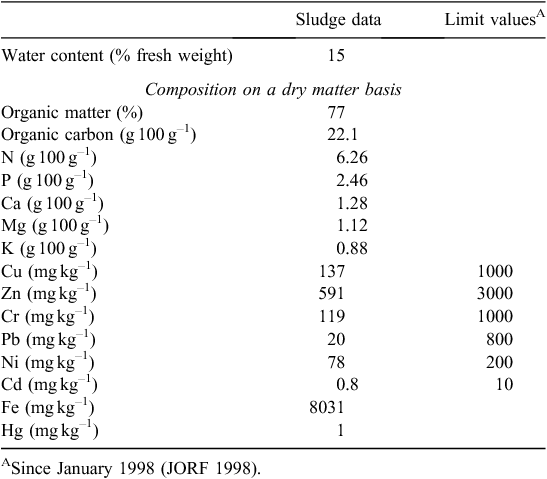
|
Soil sampling and site description
In 2005, a trial was carried out in a former plantation of Pinus caribaea to test the effects of sewage sludge on self-restoration of the plant cover from the soil seed bank. The study site was in the south of New Caledonia (22°10ʹ44.48ʹʹS, 166°42ʹ41.69ʹʹE; altitude 145 m). Meteorological records since the start of the test give the mean annual rainfall as 1800 mm, annual mean temperature 23°C, and average global radiation 1870 J cm–2 day–1 (Bonvallot et al. 2013).
In each plot, soil was sampled using an Edelman auger (AMS Inc., American Falls, ID, USA) to a depth of 20 cm. Ten units were randomly taken, placed into a polyethylene bag and vigorously homogenised. The soil samples were then dried in the open air for 72 h and sieved to 2 mm. The red-coloured soil was an Acric Ferralsol according to World Soil Reference Base, naturally poor in organic matter as described in Table 2. The pH of the soil was ~5, and as expected for an acid soil, the cation exchange capacity was very low. The soil fertility was poor with low levels of available P; Olsen’s modified Dabin’s method (Mathieu and Pieltain 2003) gave 1.2 mg kg–1. Total N was analysed by the Kjeldahl method (Bremner 1996). Trace element content was determined in aqua regia digest; 3 g soil was mixed with 21 mL HCl and 7 mL HNO3 for 12 h, then heated to 150°C for 2 h, according to ISO normalisation (ISO 11466). Trace metals were present in low amounts, except Cr, Zn and Ni. The Cr, analysed by atomic absorption spectroscopy and then polarography, was not in the highly toxic Cr(VI) form but mainly occurred as Cr(III) (oxides and hydroxides). Both aqua regia and alkaline fusion extraction gave the same values, except for Zn, where the aqua regia value (76.3 mg kg–1) was within with regulatory requirements (300 mg kg–1) whereas alkaline fusion dissolved all of the Zn, resulting in higher levels (356 mg kg–1), which were therefore above the norm. Soil levels of Cr and Ni were also above the norm for soils considered suitable to receive sludge. These were total soil concentrations and not bioavailable concentrations.
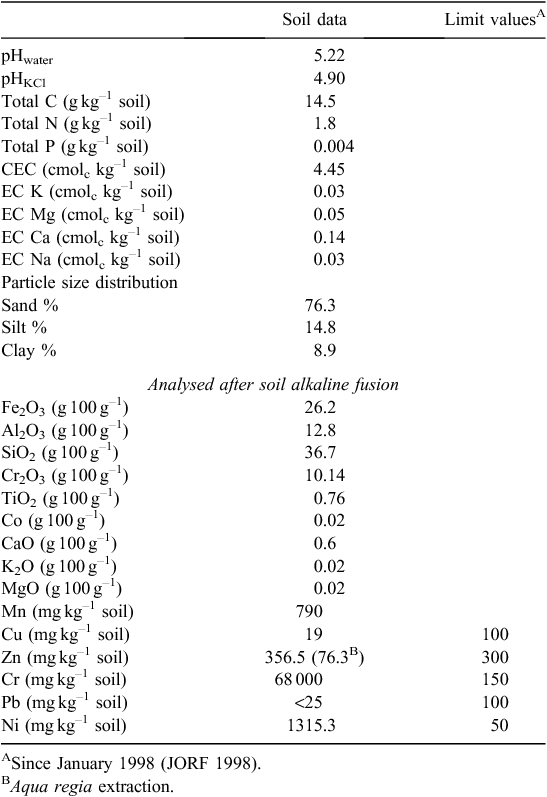
|
The experimental zone comprised two 6-m-long bands covering a total surface area of 0.1 ha (Fig. 1). Within this area, five main plots were marked out and each was separated into five subplots. Each subplot measured 5 by 5 m and was surrounded with a 1-m buffer zone to allow movement around the subplots and to limit subplot interactions.
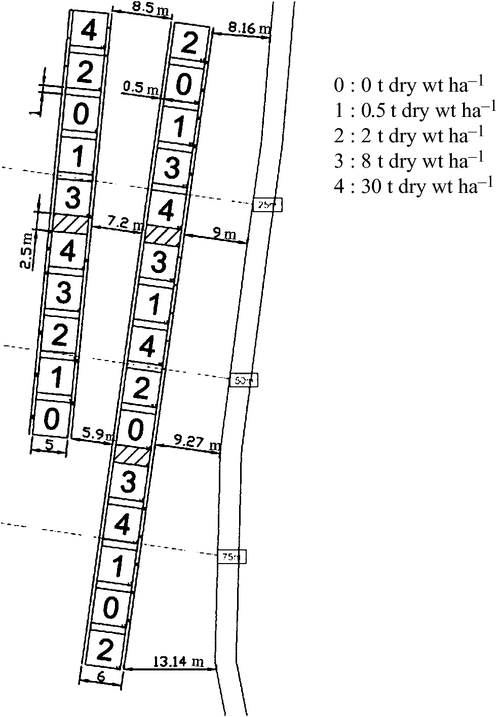
|
Experimental design
To prepare the experimental plots, both strips of land were completely cleared of vegetation. The stumps of the old planted pines were mechanically removed and the rest of the vegetation was flailed to fragments. The topsoil was tilled to 20 cm depth with a grubber, and the plots were marked out with wooden corner posts.
Sewage sludge was taken at the outlet of the water treatment station and transported directly to the experimental site for immediate spreading in September 2005. All five subplots from each main plot were randomly amended with one of five sludge dosages: 0 (control subplot), 0.5, 2, 8 and 30 t dry weight (DW) ha–1. The dewatered fresh sludge was manually spread on the surface of each plot and rotavated into the soil to 20 cm depth.
Vegetation monitoring and sampling
Observations were conducted on the plants that had emerged from the seeds naturally present (soil seed bank). Species composition was dominated by three plants. Follow-up work focussed on two or three dominant species, based on the data obtained. Measurements were repeated 2.5, 3, 3.5 and 5 years after sludge application. Mortality was calculated between two measurements.
In 2010, the aboveground biomass of all of the dominant species was removed and all other species were sampled on 10% of the surface of each treatment plot. The different parts of the plants (stems, foliage and branches) were separated and weighed. Samples from each treatment and each subplot were dried for 1 week at 60°C in an oven for analysis. Separation of different plant parts was not the same in all species, i.e. trees were separated into three compartments (foliage, branches and stems) and shrubs into two compartments (stems and foliage). Total aboveground biomass was also measured.
Chemical analyses
Vegetation samples were digested with concentrated HNO3/H2O2 in a digestion apparatus (DigiPREP: SPS Science, Quebec), and P and heavy metals in the digest were determined using inductively coupled plasma-mass spectroscopy (ICP-MS) (Agilent 7700; Agilent Technologies, Santa Clara, CA, USA).
The mineralisation accuracy was estimated using tomato leaves (1573A, NIST) as a standard reference material. Depending on the metal, recovery was ~80%.
To assess N uptake by plants (except the dominant species), samples were digested in sulfuric acid and hydrogen peroxide at high temperature (440°C) in a digestion apparatus (Digesdahl®, Hach Co., Loveland, CO, USA). Nitrogen was quantified with Nessler’s procedure using a DR5000 spectrophotometer (Hach procedure). Carbon and N in the dominant species (P. caribaea) were determined by CHN method on powdered samples.
Statistical analyses
The effect of the amendment on tree heights, mortality, and nutrient and heavy metal concentrations in biomass was evaluated using a one-way analysis of variance (ANOVA). A Kruskal–Wallis one-way ANOVA on the ranks was used when normality or equal variance tests failed. When the difference between treatments was found to be significant, multiple comparisons were made using Tukey’s or Dunn’s tests. Comparisons of mean heights of a single plot between two measurement periods were analysed using a t-test. All statistical analyses were carried out using SigmaPlot v11 software (Systat Software Inc., San Jose, CA, USA). For trace element comparisons, a two-way ANOVA was carried out to compare treatments, plant parts and their interactions (treatments × plant parts).
Results
Properties of sewage sludge
Concentrations of N and P were high (6.26% and 2.46%, respectively, in sludge DW; Table 2). Calcium (1.28%) and Mg (1.12%) were also quite high. Therefore, the sludge was relatively rich in the major nutrients (N, P, Ca and Mg). Concentrations of trace elements were low and well below the French limits for land application (JORF 1998), even for Ni and therefore should not limit use through land application.
Plant cover after 5 years
Five years after spreading of sludge, the plant cover on all subplots of the experimental site was mainly accounted for by the exotic tree P. caribaea, a local shrub Sannantha leratii, and an endemic grass Costularia comosa. As mentioned, P. caribaea was introduced into New Caledonia in forestry plantations to enhance wood productivity but is now considered as an invasive species. Sannantha leratii (Myrtaceae, previously named Babingtonia leratii) is a small shrub (~1.5 m) with rapid growth and low water and sunlight requirements. It is frequently found among the scrub growing in mining spill on ultramafic substrate. Costularia comosa (Cyperaceae) grows in clumps of diameter up to 1.5 m. It also contributes to mining scrub.
These three species showed very different behaviour regarding density (Fig. 2). Pinus caribaea showed a constant density for the first four treatments (~1.1 trees m–2) and then a sharp drop (0.2 trees m–2) for the highest dosage treatment. The density of S. leratii decreased from 1 to 0.1 shrub m–2 as the sludge dosage increased. In the case of C. comosa, density increased for the first two treatments and then decreased for the last three, higher dosages. The highest density was at 0.5 t DW ha–1, while density was zero at 30 t DW ha–1.
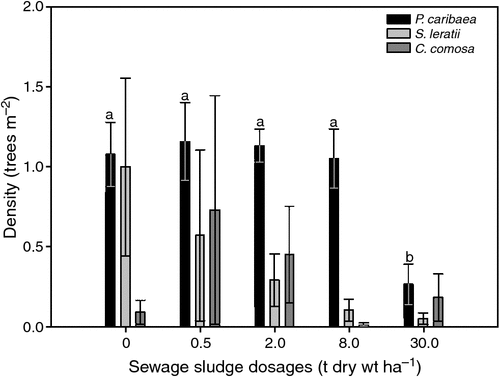
|
Sannantha leratii and P. caribaea were the most recurrent ligneous species in this experiment (Fig. 3), and therefore, they were the only two considered separately for the biomass and nutrient study. Costularia comosa was considered only in the ‘Other’ group because it did not present enough biomass. The ‘Other’ group included another indigenous grass (Lepidosperma perteres), juvenile trees (Myodocarpus fraxinifolius, Alphitonia neocaledonica, Eugenia sp., Cloezia sp.), an exotic grass (Paspalum sp.), lichen (Cladonia pycnoclada) and moss. Litter was defined as all dead plant material deposited on the ground.
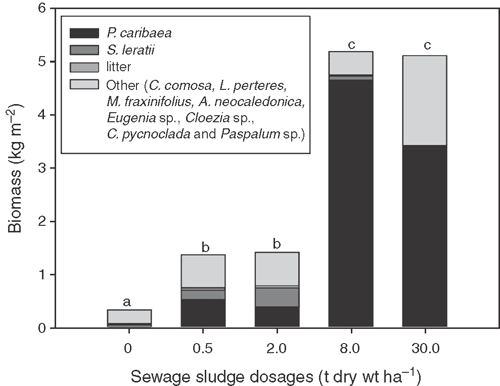
|
The total aboveground biomass is presented (Fig. 3) for the control and four treatment groups (kg dry biomass m–2): 0.32 for the control; 1.35 and 1.40 for 0.5 and 2 t DW sludge ha–1, respectively; and 5.17 and 5.10 for 8 and 30 t DW sludge ha–1. For the three lowest sludge treatments, P. caribaea biomass was less than that of the rest of the biomass (S. leratii and ‘Other’). For the two highest levels of sludge application, the P. caribaea biomass was dominant. For the 30 t DW ha–1 treatment, ‘Other’ was mainly represented by Paspalum sp. (95%). For P. caribaea biomass, the foliage represented 30% of total biomass, stems 60% and branches 10%.
Plant cover was diversified but dominated by pine trees, which alone were to be monitored for the whole 5 years.
Pine tree mortality and growth
Pine germination was highest on the control plot (Fig. 4). After a 2.5-year growth period, the tree density on each plot decreased from 1.2 ± 0.1 to 0.3 ± 0.1 plants m−2 with increasing sludge dosage. Nevertheless, only the plots treated with 30 t DW ha–1 of sewage sludge presented a significantly lower density of trees during the whole 5 years of monitoring (P < 0.01).
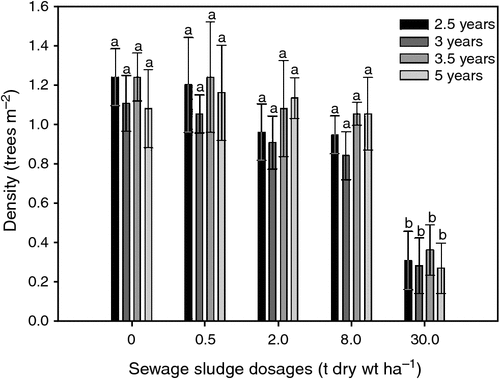
|
Between the first and second measurement, the control series presented the highest plant mortality (25%) compared with the highest dose (14%). Between the second and the third measurements, new pines trees emerged so no overall mortality was observed. However, between the third and the last measurement, mortality occurred once more. In general, due to the appearance of new trees, between the first and the last measurement, mortality appeared only for the control plot (20%).
Increasing the sludge level in the soils resulted in an increase in pine height (Fig. 5). Comparison of all five treatments, at each measurement time, indicated a first group with the highest growth (including the treatments 8 and 30 t DW ha–1) and a second group with the lowest growth (including the treatments 0.5 and 2 t DW ha–1), with no significant differences observed within groups (P = 0.132 and P = 0.051 for the first and second groups, respectively, after 5 years). Sapling heights in these two groups were significantly greater than in the control group (P < 0.001). This means that growth was greatest for the highest level of amendment, 30 t DW ha–1.
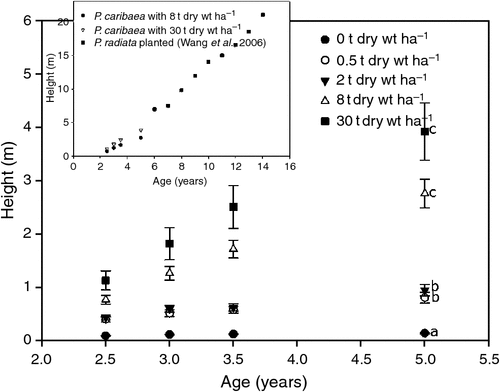
|
During the five years of the experiment, pine growth rates were linear and can be represented by the slope of each regression. All linear models were significant (P < 0.01) except in the case of the control plot (P = 0.056). Moreover, all slopes were significantly different from zero except that for the control plot. With no amendment, the growth rate was 0.018 m year–1. For the treatment 2 t DW ha–1 the growth rate was 0.20 ± 0.01 m year–1, for 8 t DW ha–1 growth rate was 0.78 ± 0.05 m year–1, and for 30 t DW ha–1 growth rate was 1.10 ± 0.08 m year–1. Treatments with low dosages showed similar growth rates (0.16 and 0.20 m year–1 for 0.5 and 2 t DW ha–1, respectively; P > 0.05). For the highest level of amendment, growth rates were significantly higher (P < 0.001). The growth of trees in the current study (Fig. 5) for treatments 8 and 30 t DW ha–1 agree with the study of Wang et al. (2006), who reported similar growth for a plantation of P. radiata.
Moreover, application of amendment significantly increased diameter of P. caribaea trees and, consequently, tree volumes. There was a direct relationship between height and diameter of pines; after 5 years without sludge, average diameters were 0.01 m for 0.08 m height. With sludge treatment of 30 t DW ha–1, average diameters were ~0.09 m for a height of 6 m.
Nutrient content in biomass
Regardless of species, the distributions of N and P concentrations in the plant were similar (Fig. 6). Across treatments, the concentration of N in P. caribaea (Fig. 6) was significantly higher in foliage than in stems and branches (P = 0.010 and P = 0.020 for stems and branches, respectively). Nevertheless, groupings were not clearly established between treatments for foliage, except for the control plot where foliage N was significantly higher than for all other treatments. The level of N in S. leratii (foliage and stems) showed no difference between treatments. However, concentrations were higher in foliage than in stems for each treatment, as for P. caribaea.
For P concentrations in P. caribaea, no significant differences occurred across treatments except at 2 and 30 t DW ha–1, where P in foliage was found to be higher than in branches. Unlike the N concentration in S. leratii, the P concentrations were statistically higher (0.22% for foliage and 0.04% for stems) at the highest application levels. Unlike N, in both parts of the plant, P concentration was highest in the higher treatment plots. Whatever the species, there were no statistical differences in the concentrations of P and N.
The biomasses of species were, however, very different, so the quantities obtained for each species were different, by a factor of 10 for P. caribaea. Expressed per unit biomass (Fig. 7), the shape of the graphs changed drastically between the two plant species. Nitrogen and P quantities were >100-fold greater in P. caribaea than S. leratii. Considering P. caribaea, the quantity of N and P increased with sludge application rate. By contrast, the quantity of N and P in S. leratii increased with sewage sludge dose for the first three doses, and then decreased with the two highest doses.
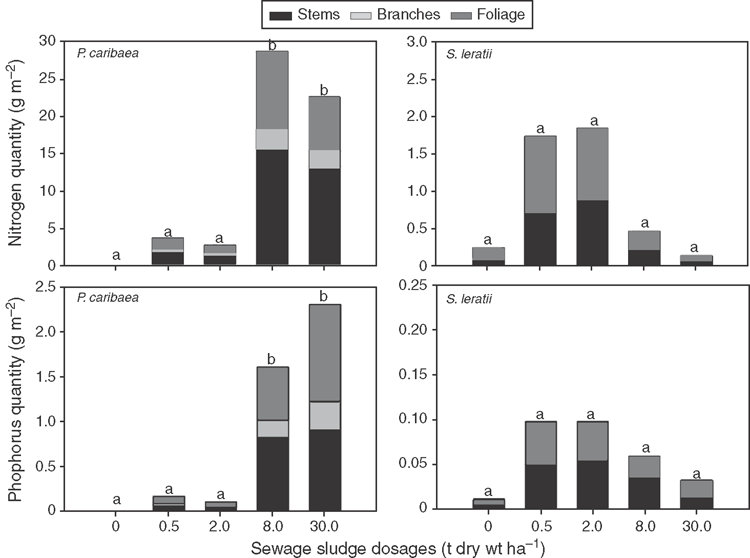
|
Available soil phosphorus
Five years after sludge application, the amount of soil P potentially available for the plant showed two main trends (Fig. 8). The first comprises the four treatments with 2–10 mg P kg–1. The second trend was for the sludge treatment of 30 t DW ha–1, with ~80 mg kg–1 of P potentially available for plants, which was ~8 times higher than with the other amendments. This treatment had a significant effect on soil P availability.
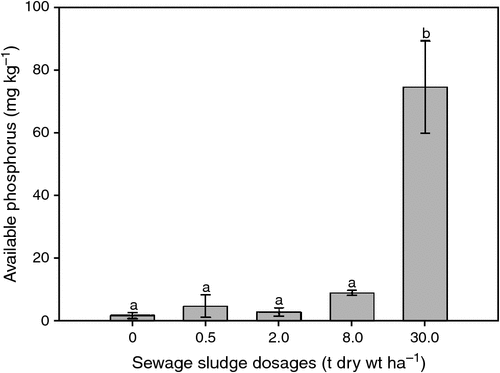
|
Clearly from Figs 6 and 8, a good correlation exists between the concentration of P in plants and the potentially available soil P extracted with Olsen’s modified Dabin’s method.
Carbon content in pines
The carbon concentration in the aboveground biomass of P. caribaea ranged between 48% and 51% of the dry weight (Fig. 9). The level of carbon in P. caribaea was greater in stems than in other compartments. In branches, when this compartment was relevant, carbon levels were lower than in either foliage or stems. Furthermore, the amount of carbon stored in the form of biomass was negligible for the first three treatments, whereas for the last two the quantities were high. The maximum amount stored in plants in the treatment 8 t DW ha–1 was 1.4, 0.6 and 0.2 kg m–2 for stems, foliage and branches, respectively.
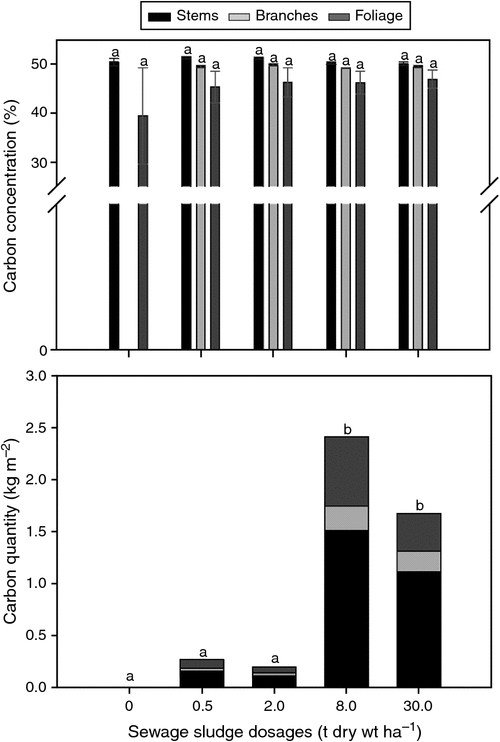
|
Pine carbon storage in biomass was ~2 t C ha–1 for treatments of 0.5 and 2 t DW ha–1 and ~20 t C ha–1 for the two highest sludge treatments. With no sludge, carbon storage by pine trees was only 0.003 t C ha–1.
Plant heavy metal content
Trace element concentrations in the aboveground biomass (Table 3) are specified by treatment, by plant part, and in whole aboveground biomass. For the branch compartment, there were no data for the control plot as no branches had formed.
Trees from the control plot were very small and covered with earth dust. Despite repeated rinsing, a little dust always remained on the plants. Consequently, the geochemical signature of the soil influenced the metal analysis values, resulting in high amounts of Cr, Ni, iron (Fe) and aluminium (Al) in the small plants of the control plots. Accordingly, for this plot, only values from the two highest and least dusty trees were noted. Due to its low representativity, the control plot was not taken into account for statistical studies of metal distribution. Regarding the effect of sludge treatment on metal concentration in the different parts of the plants (stems, branches or foliage), no significant differences were observed for most trace metals. However, Al and Ni did present small differences; in foliage, Al concentrations were significantly higher in the 30 t DW ha–1 treatment than in the two lowest treatments (0.5 and 2 t DW ha–1); for Ni, stem concentrations were significantly greater for the highest sludge treatment than for the others. Except for these two metals, no effect of sludge dose on metal absorption was evident. Due to contamination with the soil, control plot values showed higher values.
Regarding the effect of plant compartment on metal concentration for the different sludge treatments, no significant differences were observed for Mg, Cr, Fe, Ba or Cd. For Al, Ca, Co, Mn, Zn and Ni, the foliage concentrations were usually significantly greater than the concentrations for all sludge treatment levels. For Cu, differences were not as clear.
Two-way ANOVA performed only on the amended plots indicated that combined effect (treatment × plant compartment) had no effect on plant metal absorption. For metal concentrations in the whole plant, the highest were found in the control plot where contamination with soil may occur. Some trace elements appeared to slightly increase with sludge treatments (Al, Fe, Co, Ni, Zn, Ba); nevertheless, no significant differences were established.
Discussion
In this study, seeds from the topsoil were left to germinate spontaneously. The composition of the resulting plant cover depended on the dosage of sewage sludge applied; for the lowest doses, the soil still presented low fertility and was favourable for native species, the main ones being S. leratii and C. comosa. By contrast, for the highest levels of application, the soil was greatly enriched and more favourable to exotic species suited to these conditions. Consequently, P. caribaea and Paspalum sp. predominated, and although native species germinated they were unable to develop.
The density of successfully germinated pine seedlings decreased as amendment increased. The salts contained in the sludge, leading to high electrical conductivity, might have a negative effect on germination as previously shown by Myers and Couper (1989). Although the control plot presented higher pine densities, mortality was higher but decreased when the soil was amended. Selivanovskaya and Latypova (2006) showed that sludge application decreased the mortality of Pinus sylvestris. However, increased mortality has been observed for P. echinata and P. taeda (Berry 1977) and adult P. caribaea (Watanabe et al. 2009). This effect was attributed to competition through the growth of herbaceous plants leading to water depletion.
In the current study, P. caribaea growth was greatly improved with amendment by sludge. Other authors have demonstrated improvement of pine growth following application of organic amendments: P. sylvestris (Selivanovskaya and Latypova 2006), P. radiata (Kimberley et al. 2004; Wang et al. 2004) and P. halepensis (Bastida et al. 2007). In the present study, the growth of P. caribaea was low in the control plots, indicating that this low-nutrient soil was not suitable for the natural development of this species at this site. After 5 years on the control plots, the mean height of the pine trees was just ~15 cm. As demonstrated in the experiment of Srivastava et al. (1979) and Maghembe and Redhead (1984), this corresponds to the height of a 6-month-old P. caribaea grown in pots with NPK mineral fertiliser.
In the present study, the growth rate of P. caribaea was obviously improved by sludge application, reaching 1.1 m year–1 at the highest dose. These values are in accordance with results from plantation experiments (Srivastava et al. 1979; Maghembe and Redhead 1984; Arias et al. 2011). Whereas previous experiments were mainly conducted with inorganic fertilisers and transplanted trees, our study concerned spontaneous revegetation and organic amendment in a single application. Wang et al. (2006) reported 1.75 m year–1 in an experiment with a plantation receiving two sewage sludge amendments (600 kg N ha–1). For a 6-year-old P. caribaea stand, Arias et al. (2011) reported 1.7 m year–1 but in very fertile Andic soil. According to those authors, growth rates were more dependent on soil conditions and quality than on genetic variability.
Sewage sludge improved tree growth and, consequently, biomass production. In the present study, the productivity of the pines with the highest levels of application was ~8–10 t ha–1 year–1, which is slightly under values reported for this species. Egunjobi and Bada (1979) and Arias et al. (2011) obtained aboveground biomass of 10–12 t ha–1 year–1. Ambagahaduwa et al. (2009), with data from the literature, developed a polynomial relationship estimating the P. caribaea biomass with stand age. The model takes account of available literature data (15 species of pines trees) and is therefore mainly based on plantations receiving inorganic fertilisation. Large variations may be observed due to location, altitude, rainfall, stand management, tree densities. Nevertheless, the estimated value from this polynomial model was 8 t ha–1 year–1. In fact, pine productivity from a self-regenerated system using sewage sludge may result in the same productivity range as a planting system. From this biomass, the stem represents the major compartment of the tree (nearly 60%). This is in accordance with data usually reported in the literature for this species, where the trunk represents 70% of the total aboveground biomass for a 6–10-year-old P. caribaea population (Egunjobi and Bada 1979). The same values were obtained by Arias et al. (2011) for trees >14 m high. For smaller trees (<8 m), the stem biomass only represents 50% of the total aboveground biomass. The proportion of stem thus seems to increase with the height of the trees. In our study, foliage (needles) represented the second compartment of the aboveground biomass (30%). This was not the case in the study of Arias et al. (2011) where the proportion of foliage was <10%. The organic amendment used here seems to be favourable for pine foliage development.
Pinus caribaea and S. leratii nutrient contents were greater in needles than in stem and branches. For N, the needles presented the highest levels of nutrient whatever the amendment level. For P, only the highest level of amendment presented a significantly higher concentration in needles (near 0.2%). This nutrient distribution was also in accordance with literature values focussing on plantations (Egunjobi and Bada 1979; Kadeba 1994; Bramryd 2002; Wang et al. 2004), whereas the current study concerns passive restoration.
The P contribution to P. caribaea growth may be linked to a deficiency in this nutrient. As presented in Güsewell (2004), for the terrestrial ecosystem, N : P ratios (w : w) <10 and >20 correspond to N- and P-limited plants, respectively. In the current study the N : P ratio of the sewage sludge was ~2.5, which means that P was in excess with respect to N. In our control experiment, the N : P ratio in whole pine plants was near 28. This value therefore corresponds to P-limitation of tree growth. A sludge application 0.5–8 t DW ha–1 resulted in whole-tree N : P values of ~15. The trees thus do not seem limited for either of these nutrients. With the highest level of amendment (30 t DW ha–1), the P input was relatively high and pine trees became N-limited (N : P = 5). This may explain how the plots with the highest level of amendment still showed available P higher than with the other treatments even 5 years after spreading. Wang et al. (2004), for P. radiata amended with sewage sludge, observed N : P ratios <9, which indicates borderline N limitation, in contrast to most other studies. Srivastava et al. (1979) and Manikam and Srivastava (1980) observed for P. caribaea, in plastic pots, that P was the only element that promoted height gain. According to those authors, the most striking effect was achieved with a contribution of 330 kg P ha–1, resulting in a growth of 30 cm height in 6 months. In our field experiment, for a similar dosage but of organic form, the effect of P was confirmed on growth from sludge application at 8 t DW ha–1. Phosphorus is an essential nutrient and may be insufficient in ultramafic soils, where it is immobilised by ferrous oxides, reducing its availability for plants. However, Gavalda et al. (2005) found that, in an Alfisol, the P-extractable content was enhanced by sludge supply and this was observable in our study for the highest dosage where P was in excess. This is interesting because the current study concerns a soil containing much more iron oxide than the soil used in Gavalda et al. (2005).
The nutrient content in pine trees implies nutrient storage in the biomass. For Egunjobi and Bada (1979), this storage in the total aboveground biomass of 6-year-old P. caribaea was 1 g P and 22 g N m–2. For the stems only, those authors found 0.4 g P and 10 g N m–2, similar to levels reported by Arias et al. (2011) of 0.5 g P and 11 g N m–2. These data were in accordance with our values for applications of 8 and 30 t sludge ha–1, with organic input for passive restoration compared with mineral fertilisation and planting.
In the current study, an average of 50% of the tree biomass was stored carbon, which is in agreement with literature values; the stem, the main part of the aboveground biomass, presented the highest carbon content, followed by branches and needles. Arias et al. (2011) observed the same distribution in several trees including P. caribaea. For those authors, carbon storage in their pine specimens (50 years old) was 74 t C ha–1. For P. sylvestris (a 69-year-old stand; Janssens et al. 1999) and P. radiata (a 16-year-old stand; Guo et al. 2008), mean carbon storage was ~90 and 75 t C ha–1, respectively. For P. ponderosa, Laclau (2003) estimated 44 t C ha–1 of carbon storage in the aboveground biomass at different sites (15–20-year-old stand); moreover, the author observed that the total carbon storage in biomass was dependent on the total rainfall at the stand. As at our experimental site rainfall was sufficient (1800 mm year–1), and the total carbon storage in pine biomass depended on the nutrient supply to the soil. With no amendment, carbon storage was negligible, whereas for the highest sludge treatments, mean carbon storage in 5-year-old P. caribaea was estimated at 15–20 t C ha–1. For the same species, in an 18-year-old stand, Shin et al. (2007) estimated aboveground carbon storage at 60–130 t C ha–1 depending on the stand soil quality. These values represent mean annual storage of 3–7 t C ha–1, i.e. 15–35 t C ha–1 for a 5-year-old stand. These values are in accordance with our experimental measurement, implying that using sewage sludge with spontaneous regrowth results in as much carbon storage as in a pine plantation. Thus, sewage sludge may be considered as assisting carbon storage in biomass, as recently reported for farm manure (Ghosh et al. 2012).
Soils derived from serpentines are especially elevated in Cr, sometimes to >100 000 mg kg–1. Despite the very high Cr soil concentration, this element was poorly available, only 2 μg g–1 in whole plant compared with values from Kabata-Pendias (2011), who found higher concentrations of Cr in pine trees in the Ukraine: 4 mg kg–1 for older needles, 1.6 mg kg–1 for branches and 0.3 mg kg–1 for wood. Effectively, in ultramafic soils, Cr occurs mainly in the insoluble phases. However, organic substances added in the sewage sludge to the soil caused a significant increase of two Cr species, one associated with hydrous oxides and the other bound to organic matter (Kabata-Pendias 2011). That may explain why Cr concentration was very low in plants. Regarding plant effects, Cr is not subjected to specific uptake but Cr compounds were reported highly toxic to plants and detrimental to their growth and development (Shanker et al. 2005).
In the present study, concentrations were greater in plants of the control plots, so there was probably an effect of dilution in the biomass that masked concentration changes and especially an effect of the ‘soil dust’ stuck to small trees. Moreover, our values correlated with those of Wang et al. (2004), who demonstrated that the sludge did not appear to increase absorption of metals by plants. There were two exceptions: for aluminium, where values were dose-dependent, and for iron, where our values were higher, but not dose-dependent. However, the values found for iron were similar to those found by Latham and Verliere (1973) for P. caribaea in New Caledonia. Compared with that study, all values were in the range showing no particular effects from sewage sludge.
Kabata-Pendias (2011) gave approximate concentrations of trace elements in mature leaf tissues. Compared with their values, values below normal were found for Cu (5–30 mg kg–1) and Zn (27–150 mg kg–1) and normal values were found for Mn (30–300 mg kg–1). For Cr concentrations, values found were above normal (0.1–0.5 mg kg–1) but below excessive (5–30 mg kg–1). Cobalt concentrations were considered normal (0.02–1 mg kg–1) and Ni concentrations between normal (0.1–5 mg kg–1) and toxic (10–100 mg kg–1).
Conclusions
This study, performed on a Ferralsol in Southern New Caledonia, showed that although the application of sludge decreased the potential of seeds from the soil storage bank to germinate, those that did emerge showed much improved growth.
The germination established durable plant cover, essential for the prevention of erosion. The application of sludge led to an increase of nutrient availability (N and P) for the development of plants and consequently of plant biomass. For P, with the three lower doses, the sludge effect was observed only for plants, but with higher doses, it was observed for plants and also for soil. For the highest dose, P was in excess in the plant with respect to N, and consequently present in large quantities in the soil. For the ratio N : P, the optimum sludge supply leading to the maximum biomass without any P excess in soil should be slightly below 30 t DW ha–1.
Carbon storage in the biomass produced was increased at least 10-fold by the nutrient in the organic amendment spread on the land. So, sludge amendment may be used to promote trapping of atmospheric carbon. Sludge does not seem to affect the levels of metals absorbed by plants, even for Cr, which was present at high levels in the soil.
However, the application of abundant organic amendment encouraged the growth of undesirable exotic species. From these results, the optimal dose of sewage sludge depended on the objectives. The results of the current study provide valuable information to support the use of sewage sludge on New Caledonian soil. To stimulate biodiversity, optimal dosage seems to be 0.5 or 2 t DW ha–1 but to reach maximal biomass, the best level of application is 8–30 t DW ha–1, probably ~20 t DW ha–1.
References
Ambagahaduwa IM, Prasad N, Gunatilleke IAUN, Seneviratne G, Gunatilleke CVS (2009) Estimation of above ground biomass of a Pinus caribaea Morelet stand in lower Hantana. Journal National Science Foundation of Sri Lanka 31, 195–201.Arias D, Calvo-Alvarado J, deB Richter D, Dohrenbusch A (2011) Productivity, aboveground biomass, nutrient uptake and carbon content in fast-growing tree plantations of native and introduced species in the Southern Region of Costa Rica. Biomass and Bioenergy 35, 1779–1788.
| Productivity, aboveground biomass, nutrient uptake and carbon content in fast-growing tree plantations of native and introduced species in the Southern Region of Costa Rica.Crossref | GoogleScholarGoogle Scholar | 1:CAS:528:DC%2BC3MXkt12gsb8%3D&md5=a6f33552f8d041fc7b47cac6d45e42eaCAS |
Bastida F, Moreno JL, Hernández T, García C (2007) The long-term effects of the management of a forest soil on its carbon content, microbial biomass and activity under a semi-arid climate. Applied Soil Ecology 37, 53–62.
| The long-term effects of the management of a forest soil on its carbon content, microbial biomass and activity under a semi-arid climate.Crossref | GoogleScholarGoogle Scholar |
Becquer T, Petard J, Duwig C, Bourdon E, Moreau R, Herbillon AJ (2001) Mineralogical, chemical and charge properties of Geric Ferralsol from New Caledonia. Geoderma 103, 291–306.
| Mineralogical, chemical and charge properties of Geric Ferralsol from New Caledonia.Crossref | GoogleScholarGoogle Scholar | 1:CAS:528:DC%2BD3MXlvFWgu7k%3D&md5=d4108d10ea687bb06abcaf082fb71400CAS |
Berry CR (1977) Initial response of pine seedlings and weeds to dried sewage sludge in rehabilitation of an eroded forest site. Research Note SE-249. USDA Forest Research Southern Research Station, Asheville, NC, USA.
Bonvallot J, Gay JC, Habert E (2013) ‘Atlas de la Nouvelle-Calédonie.’ (IRD: Marseilles)
Bramryd T (2002) Impact of sewage sludge application on the long-term nutrient balance in acid soils of scot pine (Pinus sylvestris) forests. Water, Air, and Soil Pollution 140, 381–399.
| Impact of sewage sludge application on the long-term nutrient balance in acid soils of scot pine (Pinus sylvestris) forests.Crossref | GoogleScholarGoogle Scholar | 1:CAS:528:DC%2BD38XmvVOrt7Y%3D&md5=3cae91320f8e917603f61ba17dc27936CAS |
Bremner JM (1996) Nitrogen—total. In ‘Methods of soil analysis: chemical methods: Part 3’. (Ed. DL Sparks) pp. 1085–122. (American Society of Agronomy, Soil Science Society of America: Madison, WI)
Cox JA, Whelan RJ (2000) Soil development of an artificial soil mix: nutrient dynamics, plant growth, and initial physical changes. Australian Journal of Soil Research 38, 465–478.
| Soil development of an artificial soil mix: nutrient dynamics, plant growth, and initial physical changes.Crossref | GoogleScholarGoogle Scholar |
Egunjobi JK, Bada SO (1979) Biomass and nutrient distribution in stands of Pinus caribaea L. in the dry forest zone of Nigeria. Biotropica 11, 130–135.
| Biomass and nutrient distribution in stands of Pinus caribaea L. in the dry forest zone of Nigeria.Crossref | GoogleScholarGoogle Scholar |
Fuentes D, Disante KB, Valdecantos A, Cortina J, Vallejo VR (2007) Sensitivity of Mediterranean woody seedlings to copper, nickel and zinc. Chemosphere 66, 412–420.
| Sensitivity of Mediterranean woody seedlings to copper, nickel and zinc.Crossref | GoogleScholarGoogle Scholar | 1:CAS:528:DC%2BD28Xht1Cqt7%2FP&md5=31f4d66767256f3beba385849655c468CAS | 16870229PubMed |
Gavalda D, Scheiner JD, Revel JC, Merlina G, Kaemmerer M, Pinelli E, Guiresse M (2005) Agronomic and environmental impacts of a single application of heat-dried sludge on a Alfisol. The Science of the Total Environment 343, 97–109.
| Agronomic and environmental impacts of a single application of heat-dried sludge on a Alfisol.Crossref | GoogleScholarGoogle Scholar | 1:CAS:528:DC%2BD2MXjvV2ltL8%3D&md5=62f12d3ef0b39c5694c97b02feae97f4CAS | 15862839PubMed |
Ghosh S, Wilson B, Ghoshal S, Senapati N, Mandal B (2012) Organic amendments influence soil quality and carbon sequestration in the Indo-Gangetic plains of India. Agriculture, Ecosystems & Environment 156, 134–141.
| Organic amendments influence soil quality and carbon sequestration in the Indo-Gangetic plains of India.Crossref | GoogleScholarGoogle Scholar |
Guo LB, Cowie AL, Montagu KD, Gifford RM (2008) Carbon and nitrogen stocks in a native pasture and an adjacent 16-year-old Pinus radiata D. Don. plantation in Australia. Agriculture, Ecosystems & Environment 124, 205–218.
| Carbon and nitrogen stocks in a native pasture and an adjacent 16-year-old Pinus radiata D. Don. plantation in Australia.Crossref | GoogleScholarGoogle Scholar | 1:CAS:528:DC%2BD1cXislKksbc%3D&md5=425a975db722bc1d9491e251ea01cd91CAS |
Güsewell S (2004) N:P ratios in terrestrial plants: variation and functional significance. New Phytologist 164, 243–266.
| N:P ratios in terrestrial plants: variation and functional significance.Crossref | GoogleScholarGoogle Scholar |
Janssens IA, Sampson DA, Cermak J, Meiresonne L, Riguzzi F, Overloop S, Ceulemans R (1999) Above- and belowground phyomass and carbon storage in a Belgian Scots pine stand. Annals of Forest Science 56, 81–90.
| Above- and belowground phyomass and carbon storage in a Belgian Scots pine stand.Crossref | GoogleScholarGoogle Scholar |
JORF (1998) Arrêté du 8 janvier 1998 fixant les prescriptions techniques applicables aux épandages de boues sur les sols agricoles pris en application du décret n° 97-1133 du 8 décembre 1997 relatif à l’épandage des boues issues du traitement des eaux usées. Journal Officiel de la République Française du 01.31.1998, pp. 1563–1571. Government of France.
Kabata-Pendias A (2011) ‘Trace elements in soils and plants.’ 4th edn (CRC Press, Taylor & Francis Group: Boca Raton, FL)
Kadeba O (1994) Growth and nutrient accumulation by Pinus caribaea on three Savanna sites in northern Nigeria. Agriculture, Ecosystems & Environment 49, 139–147.
| Growth and nutrient accumulation by Pinus caribaea on three Savanna sites in northern Nigeria.Crossref | GoogleScholarGoogle Scholar | 1:CAS:528:DyaK2cXlsFKnurg%3D&md5=c2c097030babe7cc20a642fc712b7358CAS |
Kimberley MA, Wang H, Wilks PJ, Fisher CR, Magesan GN (2004) Economic analysis of growth response from a pine plantation forest applied with biosolids. Forest Ecology and Management 189, 345–351.
| Economic analysis of growth response from a pine plantation forest applied with biosolids.Crossref | GoogleScholarGoogle Scholar |
Kowaljow E, Mazzarino MJ (2007) Soil restoration in semiarid Patagonia: Chemical and biological response to different compost quality. Soil Biology & Biochemistry 39, 1580–1588.
| Soil restoration in semiarid Patagonia: Chemical and biological response to different compost quality.Crossref | GoogleScholarGoogle Scholar | 1:CAS:528:DC%2BD2sXkslOju70%3D&md5=9818266852f93e5bcea7c7966b691a18CAS |
Kowaljow E, Mazzarino MJ, Satti P, Jiménez-Rodríguez C (2010) Organic and inorganic fertilizer effects on a degraded Patagonian rangeland. Plant and Soil 332, 135–145.
| Organic and inorganic fertilizer effects on a degraded Patagonian rangeland.Crossref | GoogleScholarGoogle Scholar | 1:CAS:528:DC%2BC3cXntlGgsrc%3D&md5=7586c69fbb3e3b7f0472c6fb545422a6CAS |
Laclau P (2003) Biomass and carbon sequestration of ponderosa pine plantations and native cypress forests in northwest Patagonia. Forest Ecology and Management 180, 317–333.
| Biomass and carbon sequestration of ponderosa pine plantations and native cypress forests in northwest Patagonia.Crossref | GoogleScholarGoogle Scholar |
Larchevêque M, Ballini C, Korboulewsky N, Montès N (2006) The use of compost in afforestation of Mediterranean areas: Effects on soil properties and young tree seedlings. The Science of the Total Environment 369, 220–230.
| The use of compost in afforestation of Mediterranean areas: Effects on soil properties and young tree seedlings.Crossref | GoogleScholarGoogle Scholar | 16762400PubMed |
Larchevêque M, Montès N, Baldy V, Ballini C (2008) Can compost improve Quescus pubescens Willd establishment in a Mediterranean post-fire shrubland? Bioresource Technology 99, 3754–3764.
| Can compost improve Quescus pubescens Willd establishment in a Mediterranean post-fire shrubland?Crossref | GoogleScholarGoogle Scholar | 17719778PubMed |
Latham M, Verliere G (1973) Note sur la croissance de quelques essences forestières dans les essais de reboisement du Nord et de l’Est de la Nouvelle-Calédonie. ORSTOM Fond Documentaire n°6406 code B.
Maghembe JA, Redhead JF (1984) Growth and ectomycorrhizal development of Pinus caribaea seedlings inoculated with basidiospores of Scleroderma dictyosporum in fertilized nursery soil in Tanzania. Forest Ecology and Management 8, 221–228.
| Growth and ectomycorrhizal development of Pinus caribaea seedlings inoculated with basidiospores of Scleroderma dictyosporum in fertilized nursery soil in Tanzania.Crossref | GoogleScholarGoogle Scholar |
Manikam D, Srivastava PBL (1980) The growth response of Pinus caribaea mor. var. hondurensis bar and golf seedlings to fertilizer application on the Serdang soil series. Forest Ecology and Management 3, 127–139.
| The growth response of Pinus caribaea mor. var. hondurensis bar and golf seedlings to fertilizer application on the Serdang soil series.Crossref | GoogleScholarGoogle Scholar | 1:CAS:528:DyaL3MXhsVCitQ%3D%3D&md5=995d3e8473cc10371d6e53a697fb9a89CAS |
Mathieu C, Pieltain F (2003) Dosage du phosphore. In ‘Analyse chimique des sols: méthodes choisies’. Ch. 13. pp. 268–272. (Tec&Doc Lavoisier: Paris)
Myers BA, Couper DJ (1989) Effects of temperature and salinity on the germination of Puccinellia ciliate (Bor) cv. Menemen. Australian Journal of Agricultural Research 40, 561–571.
| Effects of temperature and salinity on the germination of Puccinellia ciliate (Bor) cv. Menemen.Crossref | GoogleScholarGoogle Scholar |
Ojeda G, Alcañiz J, le Bissonnais Y (2008) Differences in aggregate stability due to various sewage sludge treatments on a Mediterranean calcareous soil. Agriculture, Ecosystems & Environment 125, 48–56.
| Differences in aggregate stability due to various sewage sludge treatments on a Mediterranean calcareous soil.Crossref | GoogleScholarGoogle Scholar |
Petersen SO, Henriksen K, Mortensen GK, Krogh PH, Brandt KK, Sørensen J, Madsen T, Petersen J, Grøn G (2003) Recycling of sewage sludge and household compost to arable land: fate and effects of organic contaminants, and impact on soil fertility. Soil & Tillage Research 72, 139–152.
| Recycling of sewage sludge and household compost to arable land: fate and effects of organic contaminants, and impact on soil fertility.Crossref | GoogleScholarGoogle Scholar |
Rate AW, Lee KM, French PA (2004) Application of biosolids in mineral sands mine rehabilitation: use of stockpiled topsoil decreases trace element uptake by plants. Bioresource Technology 91, 223–231.
| Application of biosolids in mineral sands mine rehabilitation: use of stockpiled topsoil decreases trace element uptake by plants.Crossref | GoogleScholarGoogle Scholar | 1:CAS:528:DC%2BD3sXos1Ont7s%3D&md5=1aa1157ba6875cb36075811a40d112f8CAS | 14607481PubMed |
Richardson DM, Rejmánek M (2004) Conifers as invasive aliens: a global survey and predictive framework. Diversity & Distributions 10, 321–331.
| Conifers as invasive aliens: a global survey and predictive framework.Crossref | GoogleScholarGoogle Scholar |
Selivanovskaya SY, Latypova VZ (2006) Effects of composted sewage sludge on microbial biomass, activity and pine seedlings in nursery forest. Waste Management 26, 1253–1258.
| Effects of composted sewage sludge on microbial biomass, activity and pine seedlings in nursery forest.Crossref | GoogleScholarGoogle Scholar | 1:CAS:528:DC%2BD28XpslGhur4%3D&md5=23381a4c8ffb21fce52cd804fae36c36CAS | 16307873PubMed |
Shanker AK, Cervantes C, Loza-Taverac H, Avudainayagam S (2005) Chromium toxicity in plants. Environment International 31, 739–753.
| Chromium toxicity in plants.Crossref | GoogleScholarGoogle Scholar | 1:CAS:528:DC%2BD2MXkslSksrY%3D&md5=131cbc01e231899175d9d17297e9d4d5CAS | 15878200PubMed |
Shin MY, Miah Md D, Lee KH (2007) Potential contribution of the forestry sector in Bangladesh to carbon sequestration. Journal of Environmental Management 82, 260–276.
| Potential contribution of the forestry sector in Bangladesh to carbon sequestration.Crossref | GoogleScholarGoogle Scholar | 1:CAS:528:DC%2BD2sXhtVKku7k%3D&md5=ff3a68c437b58a0b76099cf1936a2c39CAS |
Srivastava PBL, Naruddin A, Zainorin BA (1979) The response of Pinus caribaea mor. var. Hondurensis seedlings to nitrogen, phosphorous and potassium fertilizers. Plant and Soil 51, 215–232.
| The response of Pinus caribaea mor. var. Hondurensis seedlings to nitrogen, phosphorous and potassium fertilizers.Crossref | GoogleScholarGoogle Scholar | 1:CAS:528:DyaE1MXhvVGmtb4%3D&md5=3fbf5573e9475835bfab3540eaa703adCAS |
Wang H, Magesan G, Kimberley M, Payn T, Wilks P, Fisher C (2004) Environmental and nutritional responses of a Pinus radiata plantation to biosolids application. Plant and Soil 267, 255–262.
| Environmental and nutritional responses of a Pinus radiata plantation to biosolids application.Crossref | GoogleScholarGoogle Scholar | 1:CAS:528:DC%2BD2MXht1WkurY%3D&md5=f81a04d5f36c613bccabe8a436fd2b2dCAS |
Wang H, Kimberley MO, Magesan G, McKinley R, Lee JR, Lavery JM, Hodgkiss PDF, Payn TW, Wolks PJ, Fisher CR, McConchie DL (2006) Midrotation effects of biosolids application on tree growth and wood properties in a Pinus radiata plantation. Canadian Journal of Forest Research 36, 1921–1930.
| Midrotation effects of biosolids application on tree growth and wood properties in a Pinus radiata plantation.Crossref | GoogleScholarGoogle Scholar |
Watanabe Y, Masunaga T, Fashola OO, Agboola A, Oviasuyi PK, Wakatsuki T (2009) Eucalyptus camaldulensis and Pinus caribaea growth in relation to soil physico-chemical properties in plantation forests in Northern Nigeria. Soil Science and Plant Nutrition 55, 132–141.
| Eucalyptus camaldulensis and Pinus caribaea growth in relation to soil physico-chemical properties in plantation forests in Northern Nigeria.Crossref | GoogleScholarGoogle Scholar | 1:CAS:528:DC%2BD1MXjslKit7g%3D&md5=0c46fd8d33ccd42ab540388bfc280aeeCAS |




